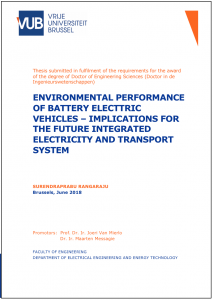
Transport is one of the most energy intensive and rapidly growing sectors, responsible for nearly a quarter of the current global energy consumption, and about a fifth of the global CO2emissions. Also, it is one of the main causes of the aggravation of air quality in the urban environment. This is because the current transport system relies almost wholly on non-renewable oil. In this context, the electrification of thetransportsystem is perceived as a vital element for energy security and the decarbonization of the whole energy system, where increasing transport electrification goes hand-in-hand with the decarbonization of electricity sector. Battery electric vehicles (BEV), charged with renewable electricity, can be a suitable alternative for conventional vehicles, especially in the urbanenvironment, because of their zero tailpipe emissions and lower well-to-wheel (WTW) emissions. However, the environmental trade-offs of such idea need to be thoroughly analyzed in a scientifically consistent way, before adoptingit into policy. Life Cycle Assessment (LCA) is a promising methodology to thoroughly assess the environmental impacts of a product, process, system or a service throughout its life cycle from a cradle-to-grave perspective.
In this thesis, a comparative LCA of different vehicle technologies in the Belgian market is performed, using an updated and elaborated inventory modelling. The scope of this study includes all the relevant life stages of vehicles namely, vehicles manufacturing, energy carrier production and supply, use phase and the end of life of the vehicles for different technologies (i.e. petrol, diesel, CNG, LPG, and EVs) in the current Belgian market. Unlike in many studies, the uncertainty caused by the market variability of the parameters like energy consumption, emissions, etc. are communicated in the results. The ReCiPe methodology has been used for the impact assessment, and the results are presented in form of mid and end-point indicators, and singlescores. The results show that the BEV has the best energy and environmental performance among the compared vehicles, when the comparison is based on the all-inclusive single score. Nevertheless, the discussions underline that the environmental impacts of EVs need to be reduced further in the areas of toxicity, resource depletion, etc. by employing cleaner production and efficient recycling technologies. Also, the possibilities for charging the BEVs with different electricity sources, and the corresponding environmental scores are compared with the conventional vehicles.
Furthermore, the impacts of the electricity mix, charging and driving profile on the environmental impact of the BEVs are assessed using the real-world data, which is widely neglected in the literature. The energy consumption, charging profiles and the driving data of BEV are obtained from the real-world data monitoring of 5 test vehicles. A dedicated modelling of the hourly electricity production and the corresponding changes in the life cycle emissions of Belgian electricity in 2015 is done, to highlight the temporal resolution of the electricity emissions and the possibilities for flexible charging of EVs. The effect of different charging time frames is discussed by coupling the charging profile of BEVs with the hourly emissions profile of the electricity. It highlights that the off-peak charging of BEVs is beneficial for the CO2savings. Furthermore, the magnitude and the causes of discrepancies between the empirical and standard derived energy consumption data of BEVs are discussed based on the test results.
In the future, the ability of the EVs in total decarbonization depends on the prospective electricity mix to supply the EV demand.Hence the role of low carbon renewables in electricity is significant. Nonetheless, the electricity sector is also rapidly changing towards renewables. In this context, this thesis examines the technical feasibility and the environmental implications of the integration of large-scale wind in the future Belgian energy system in 2030. The European forecast of the Belgian energy scenario in 2030 has been used as a basis for this assessment. A dedicated energy system modelling has been done using the “EnergyPLAN” tool. The results reveal that there is a technical capability of increasing the predicted wind capacity (6900 MW) by more than 70% in 2030. The optimal point of the integration is defined by the excess energy produced in the system, which indicates the flexibility of the system to provide back-up for the intermittency. The utilization factors of the intermittent renewable sources like wind are limited due to their non-dispatchable nature. In an integrated system, the electric vehicles with flexible charging and discharging can be used as a dynamic storage for the non-dispatchable production. Hence, the possibilities of increasing the utilization potential of wind by introducing a large fleet of BEVs scenario, replacing the ICEs and acting as a dynamic storage in the forecast system is modelled. Three BEV charging strategies namely, night charging, smart charging and vehicle-2-grid (v2g) have been modelled. The integrated transport and electricity system modelling shows that having BEVs with night/smart charging might facilitate around 13800 MW of wind capacity compared to the 6900 MW predictions. Additionally, the v2g technology can facilitate around 15000 MW wind. The integrated system level CO2emissions savings range from 10% to 28 % compared to the baseline predictions, depending on the utilization of wind energy in the system.
Additionally, from the methodological point of view, this thesis addresses the question ““Which electricity should be used while performing the environmental assessment of battery electric vehicles?”. In LCA, there are two modelling approaches, namely, 1) Attributional – accounting type using the average electricity mix and, 2) Consequential – change oriented modelling using the marginal mix. Depending on the electricity modelling approach, the BEVs can have a significant environmentalbenefits or burden compared to the ICEs. Yet, there is no global consensus on the choice of modelling. Some studies use the average electricity mix, while others use the marginal mix. This yield contradictingresults for the same system. Hence, this thesis compares and discusses the attributional and consequential modelling of the Belgian electricity mix for vehicle LCA. A detailed analysis of the applicability ofboth the modelling approaches is done. Also, this part suggested a reasonable guideline for the choice of methodology depending on the purpose of the LCA studies.
